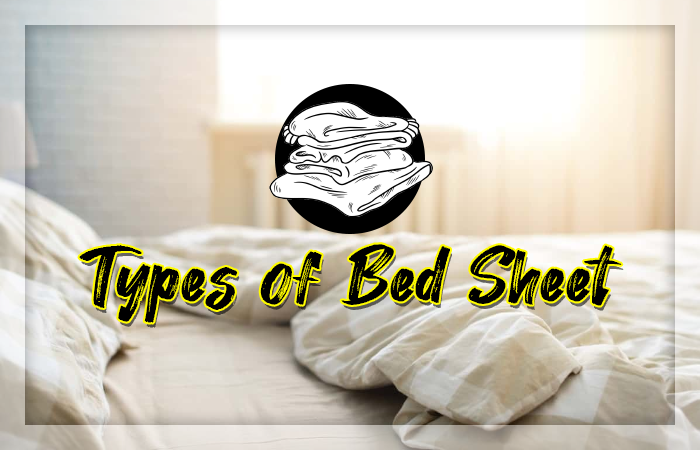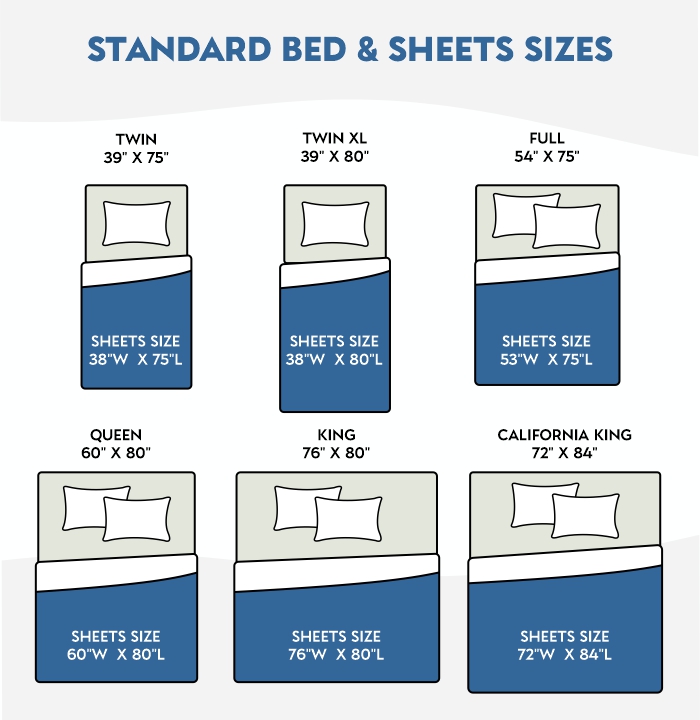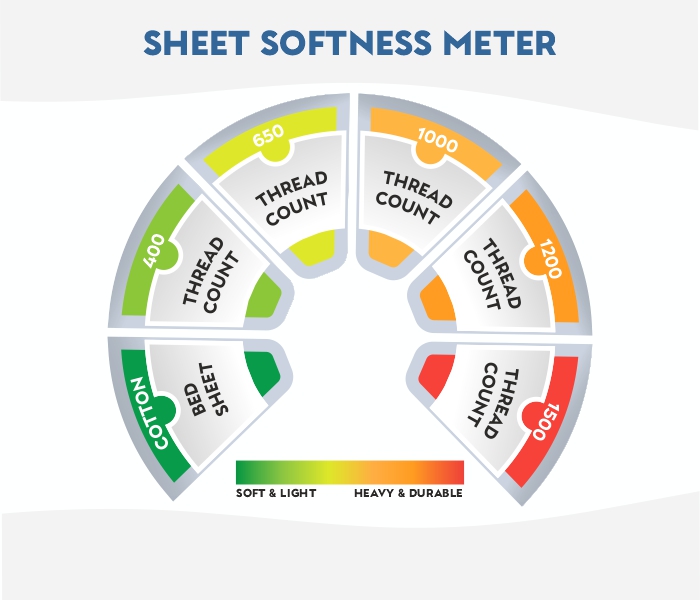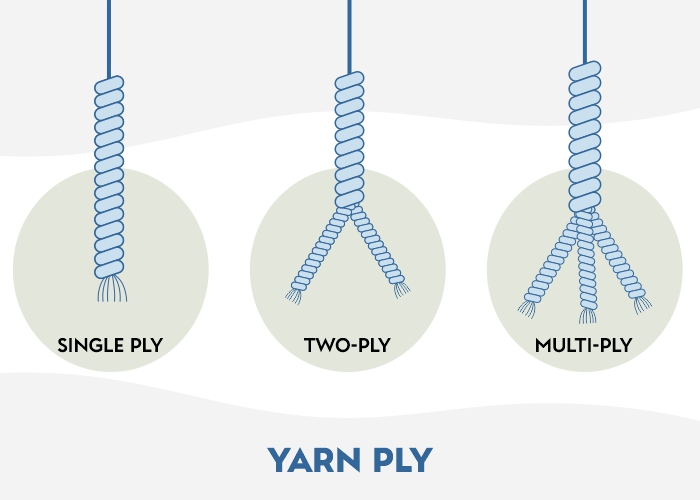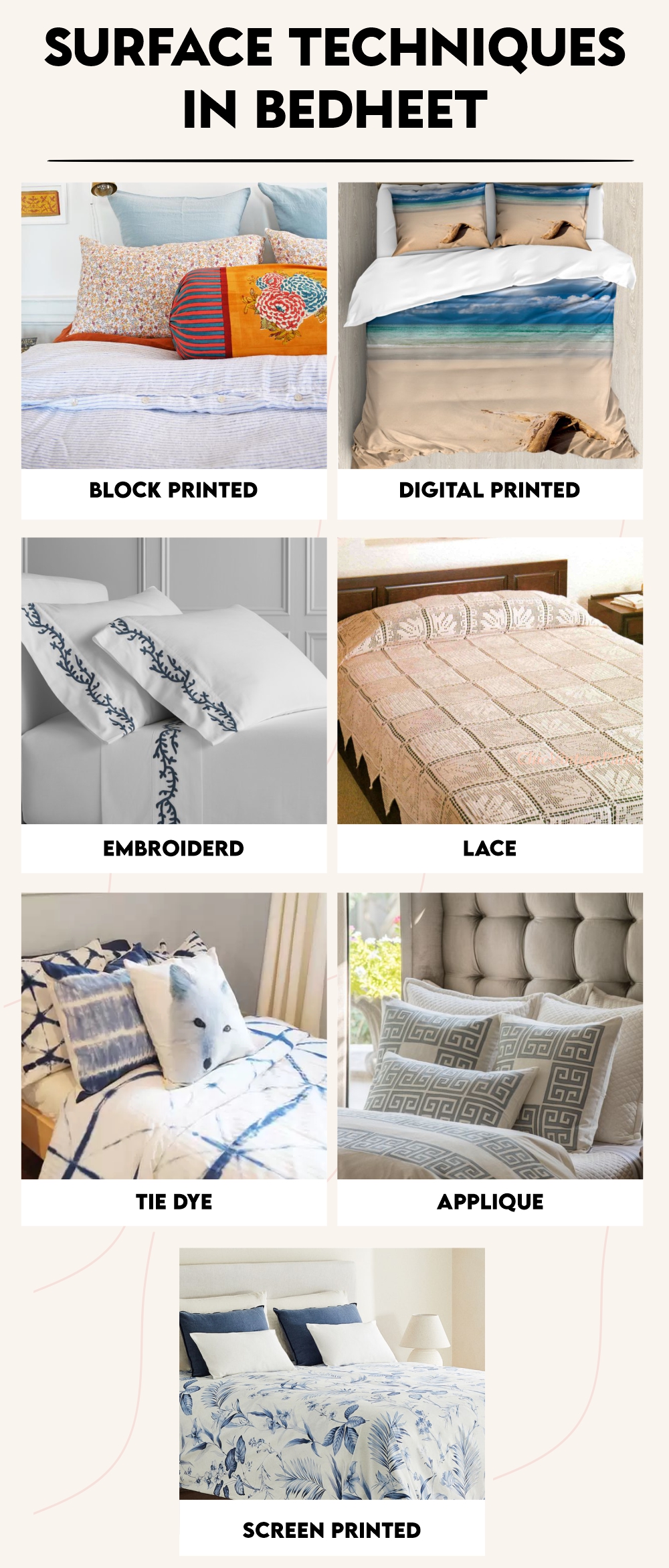Are you familiar with the thread count of your bed sheet? Oops, it sounds entirely a new term, right? But, these are not only the random jargons that exist in the world of bedsheets, in fact, but a lot of things also count in the selection of the perfect bedsheet. Probably you are not even familiar with the properties that your usual bedsheet holds. That’s the reason why many of the buyers simply hit the shopping of their bedsheets on a random basis. Wait a while, avoid acquiring any pathetic piece compiled in the range of bedsheets. Here is everything that you should know about the types of bedsheets that shape a real difference in your life.
A. Types of bedsheets based on fabric
1.Cotton
The space of bed sheets could have been incomplete without the involvement of cotton. Yes, formulating the most basic variant of bedsheets that is breathable, lightweight, soft, and quick to clean goes for the cotton ones. While it comes to cotton bedsheets there are numerous subtypes too. These are as follows.
1. Egyptian Cotton
Taking forward the legacy of Egyptian Cotton, such bedsheets are incredible since it forms through the longest staple. Also, the excellent quality follows the pricey side of Egyptian cotton bed sheets.
Pros:
-
- The supreme quality cotton.
- Perfect for year-round sleeping
- Lightweight
Cons:
-
- other than sateen weaves may have a slightly wrinkled look.
some manufacturers do not use pure fibers instead use blends of adoption and other cotton fibers.
2. Pima
Supima is the trademark of the American Pima variety of cotton that is the second-best thing that is available in the worldwide market. Redefining the charts of durability and luxurious finish a Pima cotton is totally worth your choice.
Pros:
-
- Pima is fine, long-staple cotton with a very soft weave.
- Machine washable in cold water; air dry when possible.
Cons:
-
- Poor than Egyptian cotton.
- May be blended with inferior fabrics.
3. Upland
You must have seen countless bed sheets that show off with the tag of 100% cotton. This whole percent cotton stuff is the Upland cotton that is widely scattered in the bedsheet industry and confronts the inferior quality than Egyptian or Pima cotton.
Pros:
-
- Upland cotton is significantly cheaper
- soft, comfortable, and breathable
- It is machine washable
Cons:
-
- Not the pure variety of cotton.
- less durable.
- Being made from short fibers, it is very likely to pill after a few washes
4. Flannel
Flannel cotton is the result of zillions of cotton yards shederend to create the fuzzy yet formy touch. Being medium in weight, these sheets do not embark on astounding quality and so it never hits hard in the lane of costing.
Pros:
-
- Known for durability
- Open for multiple washes
- Drapes up commendable
- Maintains an ideal body temperature. the choice for winter bed sheets.
Cons:
-
- Expensive.
- the fabric material has a coarse and dense nature
- Too heavy to use in the summer for most of the year in plain areas.
5. Jersey
Jersey is the hyper stretchable pile that you can ever opt for. Can you think of converting your cotton clothes into bedsheets? Jersey is the same kind of material that highlights the low quality and short life span.
Pros:
-
- It’s compliant to sense the best quality
- Natural stretchiness makes them wrinkle free
- Easy to care
Cons:
-
- Lacks superb quality.
- jersey sheets are not as plush as sateen or percale and will pill easier due to the lower grade of cotton used.
2. Bamboo
Yes, this environmentally friendly bamboo accepts the responsibility of crafting your bedsheets too. The process is carried out by drawing out the cellulose of bamboo that later converts into fiber known as bamboo rayon. The softness of this fabric can be sensed in a way that it’s squishy than Polyester and linen. Moreover, the anti-wrinkle perk of bamboo sheets surely stands forward as a sensible purchase.
Pros:
- Massive durable sheets
- Silky soft and smooth due to its long threads
- Brilliantly cooling material best for summers.
- Wicks moisture
- Hypoallergenic
Cons:
- Wrinkles Easily
- Gentle Care Required
- Not As Affordable As Cotton
- gentle cycle and low tumble dry
3. Polyester
If you are going to buy a Polyester sheet then hurray it will never demand the sessions of ironing. Allocating the slightly stiff fabric, polyester is unproblematic for cleaning. Besides, it is a durable pick for those who are seeking an affordable stock of bed sheets. But, this fabric will never tackle the stain of oil so always keep this in your mind while taking one.
Pros:
- Wrinkle resistant
- Economical
- quick drying properties
- low maintenance fabric
Cons:
- Not fit for excessive washing
- Not a breathable fabric,The fabric traps heat
- it is not advisable to use 100% polyester fabric for bedding purpose.
- fabric absorbs oil, oil stains and attracts dirt and dust
4. Linen
Linen is the one-go solution for people with allergies, thanks to its hypoallergenic specialty. Simplifying the bar of comfort Linen is a natural cooler too. But, the roughness could be the major drawback of these bedsheets. Furthermore, a Linen bed sheet will fall in the category of mid-price range.
Pros:
- Fabricated with an appealing rustic look.
- Softens up with every wash
- Very breathable and absorbent, it’s a great choice for summer
- Eco-friendly and fully biodegradable,
Cons:
- Rough fabric
- Inclined towards wrinkles
5. Tencel™
Tencel is basically a trademarked product from Lyocell. It’s a wood pulp extract found in a few trees, mainly in eucalyptus. The enclosed threaded process magnifies the production of Tencel bed sheets and waste generated gets recycled. Undoubtedly it’s a commendable bedsheet option for those who are concerned for the environment.
Pros:
- Hypoallergenic
- Coolest fabric
- Breathable
- Moisture-wicking and breathable
- Sustainably made, environmentally friendly
Cons:
- High in price
- Poor quality when compared to cotton
6. Silk
You all must know that silk is a product of silkworms. So, the type of bed sheets that get ready with silk is obviously the softest and luxurious. However, it requires soaring sessions of care in order to maintain the right shine.
Pros:
- Equally cooler and warmer sort of bedsheet
- Creates a royal feel.
- hypoallergenic
- Silk helps prevent tangles, frizz,
Cons:
- Most expensive, & requires dry cleaning.
- Regular care needed
- Silk fades in the sun
7. Microfiber
Up next, Microfiber is the extended form of Polyester. It’s the finest state of polyester transformed into microfibers. The best part about these sheets is that it is stain friendly. Hence, if you have kids or pets at your home then a microfiber bed sheet is a big must for you.
Pros:
- Follows long year of use
- Good weekly wash
- Very soft and smooth
- great for people who have allergies because they repel dust mites
Cons:
- Could catch fire
- Not purely environment-friendly
8. Satin
Generated through synthetic fibers, a satin sheet personifies the easy touch. Whenever you proceed to buy a satin sheet do not miss out to check it’s woven or knit. The main difference between these two is that woven is softer than knit. Although, satin sheets are the first choice of hotel owners in order of adding a shiny feel to the bedroom.
Pros:
- Shimmering fabric
- Easy to maintain
- Satin sheets don’t retain moisture
- hold color beautifully and provide year-round comfort.
Cons:
- Slippery
- Imperfect for machine wash
B. Types of bedsheets based on weave type
1. Percale
Developed with cotton, Percale sheets track one yarn under other yarn and that’s how it forms the pattern of the bedsheet. Slightly rough in the texture, percale displays wrinkles too quickly. But these bed sheets are considered excellent for warm days.
Pros:
- Turns softer with every wash
- Pocket friendly
Cons:
- Lacks the soaring scores of quality
2. Sateen
People often get confused between Satin and Sateen. You see, both of these sheets are almost the same but with a tiny difference. Instead of fibers, Sateen comprises yarns. Apart from that, likewise Satin, Sateen too is soft and shiny in appearance.
Pros:
- An apt choice for cool weather
Cons:
- Prone to wrinkles
3. Twill
Twill won its name from an over two-plus under two composition pattern. Yes, it shapes a diagonal design when it completes the process of production. You will be glad to hear that Twill sharply bears the wrinkles all due to the stiff fabric.
Pros:
- Nicely drapes over the mattress
- Distinctive designs
Cons:
- The fabric is a bit hard
4. Dobby
Dobby weaves are compiled on a dobby loom which stands out with micro geometric or themes all over the sheet. Such sheets are eminent for these stylish patterns and create comfy textures.
Pros:
- Looks like 3D bedsheets
C. Types of bedsheets based on size
Fitted Bedsheets Vs Flat Bed Sheets
Equipped with elastic edges, a fitted bed sheet settles over your bed tightly. All due to the appropriate fitting of such bedsheet there remains no scope for wrinkles. Additionally, it serves in the form of magnificent matters. These fitted bed sheets arrive with three dimensions length, width and pocket depth namely. However, the only issue that you can face while laying down your fitted bedsheet on foamy matters is that its pocket size might not fit in. Hence, if you are habitual of mattress pads we would suggest you go with deeper pockets. The standard size of the fitted sheet’s pockets ranges up to 16 inches.
Flatbed sheets are the opposite type of fitted bed sheets because they have no elastic corners. In other words, a flatbed sheet is the most basic kind which perfectly layers up to your mattress and glams up to your bed. The fringe of such bedsheets lands with sufficient area to turn easily tucked in below your mattress.
1. California King
California King bed sheet tops the chart on the ground of size. Yes, these fitted sheets occupy 16 inches pockets in order to accurately layer your mattress. It remains 72 inches wide and 84 inches long.
2. King
The second type on the size-based bedsheet section is the King-sized bed sheet. However, it is a bit similar to the California king bedsheet but the length of the two differs. King bedsheet offers 76 inches broad and 80 inches long.
3. Queen
Queen size bed sheet gives 60 inches width and 80 inches length. It’s the third-largest size.
4. Full/Double
Often called Double bed bedsheets too, a full-size bed sheet carries 53 inches in width and 75 inches in length.
5. Twin XL
Suitable for a tiny double bed set, Twin XL 38 inches broad and 80 inches long.
6. Twin
It’s the last type based on size which allocates 38 inches width and 75 inches length.
| Sheet Size | Inches | Centimeters |
| California King | ||
| Fitted Sheet | 73 in x 85 in x 15 in | 185 cm x 216 cm x 338 cm |
| Flat Sheet | 111 in x 114 in | 280 cm x 290 cm |
| King | ||
| Fitted Sheet | 73 in x 80 in x 15 in | 185 cm x 203 cm x 38 cm |
| Flat Sheet | 110 in x 114 in | 280 cm x 290 cm |
| Queen | ||
| Fitted Sheet | 60 in x 80 in x 15 in | 152 cm x 203 cm x 38 cm |
| Flat Sheet | 92 in x 108 in | 230 cm x 260 cm |
| Full/Double | ||
| Fitted Sheet | 54 in x 76 in x 15 in | 137 cm x 193 cm x 38 cm |
| Flat Sheet | 87 in x 102 in | 220 cm x 260 cm |
| Twin XL | ||
| Fitted Sheet | 39 in x 80 in x 14 in | 99 cm x 203 cm x 36 cm |
| Flat Sheet | 72 in x 114 in | 180 cm x 290 cm |
| Twin | ||
| Fitted Sheet | 39 in x 76 in x 14 in | 99 cm x 193 cm x 36 cm |
| Flat Sheet | 72 in x 102 in | 180 cm x 260 cm |
D. Different Types of Bedsheet based on Pocket Depth
1. Deep Pockets
As the term gives the right hint, deep pockets are larger enough to adjust with an extra popped-up mattress. More than 14 inches is what a pocket depth signifies. Usually, the users prefer to pickpocket depth for two primary reasons- one is obvious for blending with the huge-sized mattress and the other is, it ends up comfy to put under your mattress.
2. Standard Pockets
If your mattresses are of standard size and there are no kids at your home then you can save your money by choosing a bedsheet with standard pockets. However, it is not mandatory that all standard pocket bed sheets will cost less than deep-pocket ones since it depends on numerous other factors too.
E. Types of bedsheet basis of thread count
1. Sheet Thread Count
Thread count is the number of threads that a bedsheet contains both on a horizontal and vertical basis. The softness of any bedsheet is determined through thread count. In ancient times thread count was used as the final label of quality but nowadays buyers focus on the overall quality parameters of the bedsheet. But, if you are thinking of selecting your bed sheet regarding thread count you can even go with a smaller count because a few other things make it wholly suitable for you. For a linen sheet, the standard thread count is 120. On the other hand, a great quality cotton bedsheet holds around 500 threads.
2. Ply
Ply is the basic unit of thread count. It’s the fiber numbers that are compiled to create one thread count. Similarly, in the two-ply sheets, two fibers come together to form one thread.
F. Types of surface techniques in bedsheets
1. Handblock
Handblock is the initiative of using simple template process printing over the bedsheet. Once a template gets printed it proceeds to be applied on sheets with the help of block and stamps.
2. Digital print
Digital printing is associated with inkjet printers in which the design turns printed straight on the fabric.
3. Screen printing
A printing process that links with a sieve-like structure is addressed as screen printing. In this technique, specific colors follow the portation via a specific screen (sieve).
4. Embroidery
Highlights an embellishment procedure that constructs adorable designs. It is of two types either hand embroidery or the machine embroidery
5. Applique Technique
The technique of stitching a piece of fabric over the base fabric ends to prepare Applique bedsheets.
6. Lace
A fragile fabric of yarn or thread that usually covers the corner of the bedsheets goes for the lace pattern. It gets fixed through machines or by hands.
7. Tie-dye
In dyeing, the fabric is tied and properly dyed with the color and later composes beautiful patterns on the sheet.
Bringing in all the possible types of bedsheets you can shortlist your perfect piece by checking the fabric. Additionally, the printing technique along with the thread count leaves the leading buzz. So, be specific about your budget line plus pattern preference while finalizing your bed sheet, and sleep on with no worries at all. also check types of pillow to comfort your sleep.
Cheryl Carter
Latest posts by Cheryl Carter (see all)
- Custom Leather Patches for Hats: Elevate Your Style by Choosing the Perfect - February 27, 2024
- Types of Curtain Pleats: Explore and Elevate Your Interior Design - February 6, 2024
- Korean Perm Hairstyles Male: Get the K-Pop Look - November 24, 2023
